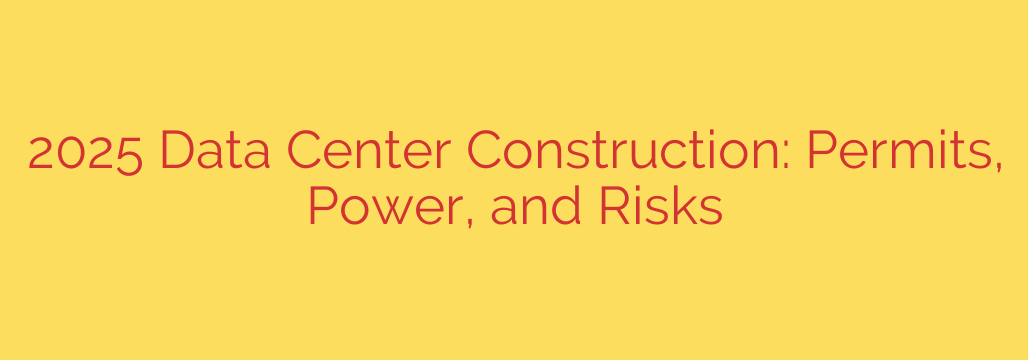
Navigating the Gauntlet: The Top Challenges Facing Data Center Construction in 2025
The global demand for data, driven by the AI revolution and our ever-connected world, has triggered an unprecedented boom in data center construction. However, developers and investors are facing a perfect storm of obstacles that are slowing projects, inflating costs, and reshaping the industry landscape. As we look toward 2025, moving from concept to a fully operational facility has become more complex than ever.
The primary challenges are not about a lack of will or capital, but about fundamental constraints in power, permissions, and resources. Successfully navigating this new environment requires a strategic, forward-thinking approach.
1. The Power Crisis: The New Primary Bottleneck
For years, the biggest hurdles in data center development were land acquisition and fiber connectivity. Today, one factor stands above all others: power.
The primary obstacle to new data center development is securing access to sufficient, reliable power. The energy demands of modern data centers, especially those designed for high-density AI and machine learning workloads, are staggering. This immense appetite for electricity is straining local and national power grids, many of which were not designed for such concentrated loads.
Key power-related challenges include:
- Grid Capacity Limitations: Many established data center hubs, like Northern Virginia and Silicon Valley, are facing power moratoriums or significant delays. Utilities simply cannot supply the multi-megawatt connections required for new hyperscale projects in a timely manner.
- Lengthy Timelines for Substations: Getting a new substation planned, approved, and built can take several years. This timeline is often longer than the construction of the data center itself, creating a major scheduling bottleneck.
- The Push for Sustainability: While essential, the transition to renewable energy sources adds another layer of complexity. Developers must now consider not only the availability of power but also its source, as clients and regulators increasingly demand sustainable operations.
Actionable Tip: Developers must now conduct power due diligence as the very first step in site selection. This involves engaging with utility providers months, or even years, in advance to understand grid capacity, future expansion plans, and potential timelines for new connections. Exploring emerging markets with available power is becoming a critical strategy.
2. The Permitting Labyrinth: Navigating Red Tape and Public Scrutiny
The days of quietly and quickly obtaining construction permits are over. Local governments and communities are now highly aware of the impact data centers have on their resources, leading to a much more rigorous and lengthy approval process.
Permitting and zoning approvals have stretched from a matter of months to, in some cases, several years. Communities are raising valid concerns about water usage (for cooling), noise pollution from equipment, and the immense strain on the local power grid. This has led to increased public hearings, more stringent environmental impact assessments, and a rise in local opposition.
Successfully navigating this requires a proactive approach to community engagement. Developers must be prepared to demonstrate the economic benefits of their project—such as job creation and tax revenue—while also presenting robust plans to mitigate environmental impacts.
Actionable Tip: Engage with local authorities and community leaders at the earliest possible stage. Transparency is key. By addressing concerns head-on and framing the project as a community partnership, developers can build goodwill and significantly smooth the path to approval.
3. Persistent Supply Chain and Labor Shortages
Even with power secured and permits in hand, the physical construction of a data center is hampered by ongoing global supply chain disruptions and a critical shortage of skilled labor.
The demand for specialized data center equipment far outstrips the current supply. Critical components like high-capacity generators, switchgear, and advanced cooling systems can have lead times exceeding 18-24 months. This forces developers to place orders long before they are needed, tying up capital and creating significant financial risk if a project is delayed for other reasons.
Simultaneously, the industry is grappling with a severe talent gap. A shortage of skilled labor—including electricians, engineers, and construction managers with data center experience—is driving up costs and extending project timelines. The complexity of modern facilities requires a specialized workforce that is currently in short supply, leading to fierce competition for qualified professionals.
Actionable Tip: Implement a multi-faceted procurement strategy. Diversify suppliers to avoid over-reliance on a single source and place orders for long-lead-time equipment as early as possible. Furthermore, invest in the workforce by partnering with trade schools and developing internal training programs to cultivate the next generation of data center construction experts.
The Path Forward: Building Smarter in 2025
The insatiable demand for digital infrastructure ensures that data center construction will continue at a rapid pace. However, the challenges of power, permits, and resources have fundamentally altered the strategic calculus. Success in 2025 and beyond will not be defined simply by building bigger or faster, but by building smarter. The developers who thrive will be those who master proactive planning, cultivate strong partnerships with utilities and communities, and build resilient supply chains to navigate the complexities of this new era.
Source: https://www.datacenters.com/news/data-center-construction-in-2025-permitting-power-and-pitfalls-to-avoid








